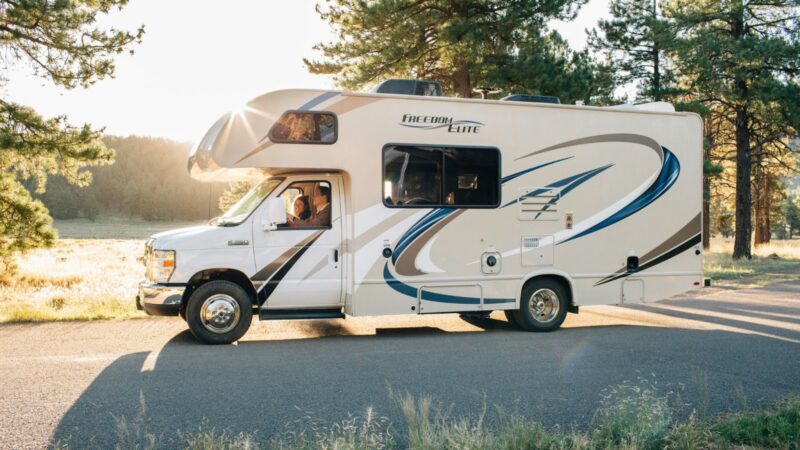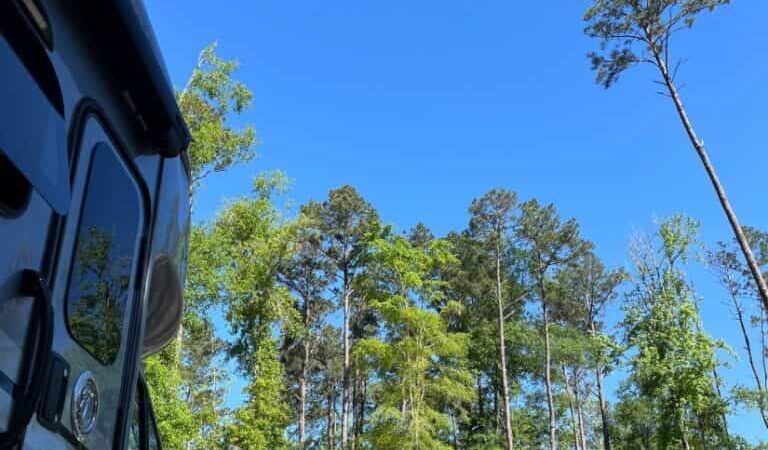RV Wind Protection: Tips And Tricks For Smoother Travels

Wind Protection Tips Every RVer Should Know
You never know what kind of weather you might run into during your RV travels. Storms are a bit easier to predict, but wind can spring up when you least expect it! But as a general rule, fall and winter tend to have more extreme weather. It can be a real hassle to protect your RV and your campsite from the wind, but there are always some things you can try. Let’s talk about wind protection and how you can stay safe in the campground and on the road!
In most cases, wind is just an annoyance. Nobody likes to deal with gusts of air ruining their hair, blowing smoke in their face, or lifting camp chairs off the ground. But there are some circumstances where windstorms become downright dangerous. It’s rare to see gusts that are strong enough to rock or tip your vehicle, but it’s always a possibility.
Being proactive against wind can make a huge difference during your next trip. You can have an infinitely better experience by tweaking a few habits and being especially careful while you’re driving. Selecting the right campground and site can also make a windy day more bearable. Read on to hear our best tips and tricks for RV wind protection this fall.
Tips for windy campgrounds
1. Park facing into the wind
The way that you park can make a big difference when you stay in a windy campground! RVs are large, and they have plenty of wide, flat surfaces. If the wind hits the side of your vehicle, it can lead to swaying or tipping. The more surface area the wind hits, the more damage it can do.
On the other hand, vehicles are designed to deal with airflow that comes from the front. Even large RVs will be more streamlined if you point them into the wind. The air will flow up and over the camper instead of rocking it from side to side.
So if you have the freedom to choose your parking position, always try to face into the wind. You might hear a bit of annoying whistling from the wind brushing past your windows, but this is much better than camping in an unstable RV.
2. Always use stabilizer jacks and wheel chocks
Next up, do everything you can to keep your RV rooted in place. A secure base and a low center of gravity will help it stay stable as it’s buffeted by the wind. Stabilizer jacks can provide extra support, plus they will help you level out your living space.
Wheel chocks are another essential item that can aid in wind protection. If you park your vehicle so that it faces into the wind, it might be blown backward. Unsecured wheels can turn more easily, especially if you’re parked on a slanted surface. Wheel chocks will ensure that your RV stays exactly where you parked it!
3. Only unfurl your awning when necessary
Awnings can provide a nice shady spot to relax, cook outdoors, or enjoy a pleasant evening. But if the wind kicks up, this fabric can catch the air like a sail! If the wind is strong enough, it could seriously damage your awning. In the worst-case scenarios, it could rip it off entirely, damaging your RV in the process.
An awning can withstand an occasional breeze, but try to keep it stowed away during windy conditions. If it’s too gusty, you probably won’t want to go outside to enjoy the awning anyway.
4. Keep tow vehicles connected to trailers
Another great way to stabilize an RV during a windstorm is to keep it connected to the tow vehicle. Of course, this piece of advice doesn’t apply to motorhomes, but they tend to be pretty stable on their own.
Travel trailers sometimes need additional support, especially if they only have one axle. The extra points of contact will go a long way. Plus, there’s even more weight to keep everything locked into place!
5. Retract slideouts during intense wind
A lot of RVs have at least one slide-out. You probably don’t think about these too much when it comes to wind protection, but an extended slide-out can be very dangerous once the weather turns stormy.
Slide-outs break up the smooth side profile of your RV and can catch the wind. They also create an uneven weight distribution and can cause the vehicle to rock from side to side. We all love slide-outs because they increase the amount of usable space in our RVs, but it’s not worth the risk when it’s stormy outside.
6. Don’t park underneath trees
Finally, you should be careful about where you choose to park. Sometimes this is out of your hands because you may be staying in a park with limited space. But if you have the option, try to park away from trees, especially if their branches stretch over the top of your RV.
Trees can drop twigs and branches during a windstorm. These can damage your roof and windshield. In the worst cases, entire trees might fall down and severely damage your vehicle. If you can, it’s better to stay away from them.
Tips for driving in windy conditions
You’ll need to follow some RV wind protection tips when you set up camp, but you should also think about how you’ll stay safe on the roads. Driving an RV through a windy area can be dangerous!
1. Check route and weather forecast
For starters, try to check the weather in advance to see if you’re likely to encounter windy or stormy weather. Some parts of the country are more prone to wind as well, so be extra careful if you’re traveling on exposed roads.
It’s always a great idea to plan your trip with an RV-specific trip planner like RV LIFE Trip Wizard. Not only does this platform provide routes that are RV-friendly, ensuring you avoid roads unsuitable for your specific vehicle, but it also incorporates a crucial weather layer feature. By utilizing the weather layers, users can access vital information about wind speeds and weather radar in their travel areas. This allows for a more informed decision-making process, helping travelers to steer clear of potentially treacherous conditions, like high winds or storms, which can be especially hazardous for high-profile vehicles like RVs.
2. Reduce your speed
Another good way to deal with the wind is to reduce your driving speed. The faster you go, the easier it is for the wind to mess with your center of gravity.
Be aware of where the wind is coming from as well. If it’s a tailwind, you might go faster than you meant to. If it’s coming from head-on, you’ll have to work harder to maintain your speed. And if it’s from the side, you need to be extra mindful about trailer sway.
Regardless of the situation, going slower will help you enjoy better control while you drive.
3. Keep both hands on the wheel
Next up, be sure to keep your hands on the wheel at all times. Gusts of wind can fluctuate from weak to strong. So if you let go of the wheel at the wrong second, you may be unprepared to deal with a sudden wind surge. Better safe than sorry! Just keep a firm hold on the wheel and be ready to correct your path at any moment.
4. Be mindful of bridges and overpasses
Wind can be a problem on any road, but it tends to grow stronger the higher you go. Overpasses and bridges can be dangerous in windy conditions. The gusts are stronger up here, and you have to be careful not to hit the edges and barricades.
As you approach a raised portion of the road, lower your speed and focus on maintaining a straight line.
5. Don’t overcorrect
Finally, beware of overcorrecting! If a surge of wind pushes you off course, you may be tempted to jerk the wheel to get right back in your lane. But if you do this, your rig could develop trailer sway. This is where the back end of your trailer begins to rock and sway back and forth.
If you attempt to correct this sway by turning more, it can become worse. In some cases, trailer sway has caused RVs to flip and crash. To avoid this outcome, you need to remain calm and focus on maintaining a straight line.
Take your foot off the gas pedal so you can slow down and regain control. You may want to flick on your hazard lights as well, so the cars around you know to give you extra space. Keep the wheel steady and don’t turn into the rocking motion. Keep going as straight as you can and pull off the road if you need to take a break.
Read campground reviews
Choosing the right campground is important. It can be the difference between an RV trip, and a great RV trip. RV LIFE Campgrounds is the most trusted source of campground information in the industry. Millions of RVers use and trust Campground Reviews, which also provides the vast resources available in RV LIFE Pro, the best tool for planning and navigating your RV trips.
Related articles:
- RVing in High Winds Doesn’t Have to be Scary
- Can High Winds Flip RVs Parked In A Campground?
- 6 Tips For Driving A Class A RV In Windy Conditions
The post RV Wind Protection: Tips And Tricks For Smoother Travels appeared first on RV LIFE.







